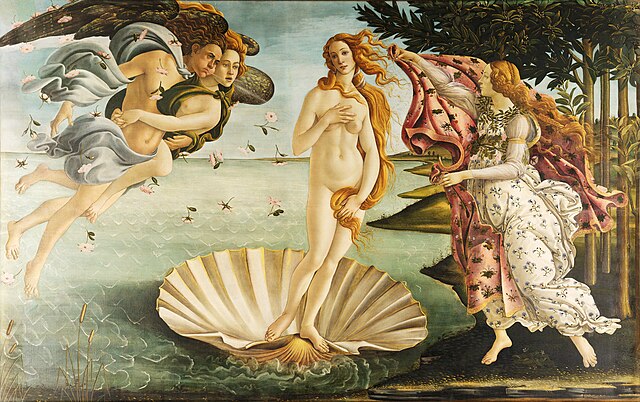“The Birth of Venus” is a famous Renaissance painting created by Sandro Botticelli around 1484-1486. It’s one of the most iconic and celebrated works of art, known for its rich symbolism and beauty. The painting portrays the goddess Venus emerging from the sea, standing on a seashell. Here are some key elements of the symbolism behind “The Birth of Venus”:
Venus (Aphrodite):
At the center of the painting stands Venus, the Roman goddess of love and beauty, and her Greek counterpart, Aphrodite. She represents love, beauty, and desire. Her arrival from the sea symbolizes her birth and association with the ocean.
The Scallop Shell:
Venus stands on a large scallop shell, which symbolizes her birth. In art and literature, the scallop shell is often associated with Venus and the sea.
Zephyr and Aura:
To the left of Venus, the figure of Zephyr (the west wind) blows, personifying the winds. He gently directs Venus towards the shore. Aura, a nymph or breeze, reaches out to clothe Venus as she lands. This gesture symbolizes the act of modesty.
Flora:
To the right of Venus, a figure, often identified as Flora, scatters roses on the ground. This action represents the arrival of spring and the blossoming of love.
Cupid:
In the sky above Venus, Cupid (Eros in Greek mythology) aims an arrow at her. His presence symbolizes the power of love and desire. It also suggests that the love between Venus and Mars, the god of war, led to the birth of Cupid.
Breezy Landscape:
The landscape and the sea in the background are depicted with a sense of movement and breeziness. This conveys the idea of a tranquil, idyllic world that complements the theme of beauty and love.
Classical Influences:
Botticelli’s painting reflects a revival of classical influences from ancient Greece and Rome, capturing the spirit of humanism and the rediscovery of classical art, literature, and mythology during the Renaissance.
Allegory of Love:
“The Birth of Venus” is often seen as an allegory of love and beauty, with Venus’s graceful form and the surrounding elements embodying the ideals of beauty, harmony, and grace.
Artistic Technique:
Botticelli’s use of line, color, and composition contributes to the overall symbolism of the painting. The soft, delicate lines and pastel colors add to the ethereal and otherworldly quality of the work.
Inspiration from Antiquity:
The painting was inspired by ancient Roman and Greek artworks, including sculptures and texts, making it a testament to the Renaissance fascination with the classical world.
“The Birth of Venus” is a masterpiece that continues to captivate and inspire art enthusiasts and scholars, with its timeless symbolism of beauty, love, and the human connection to the natural world.










